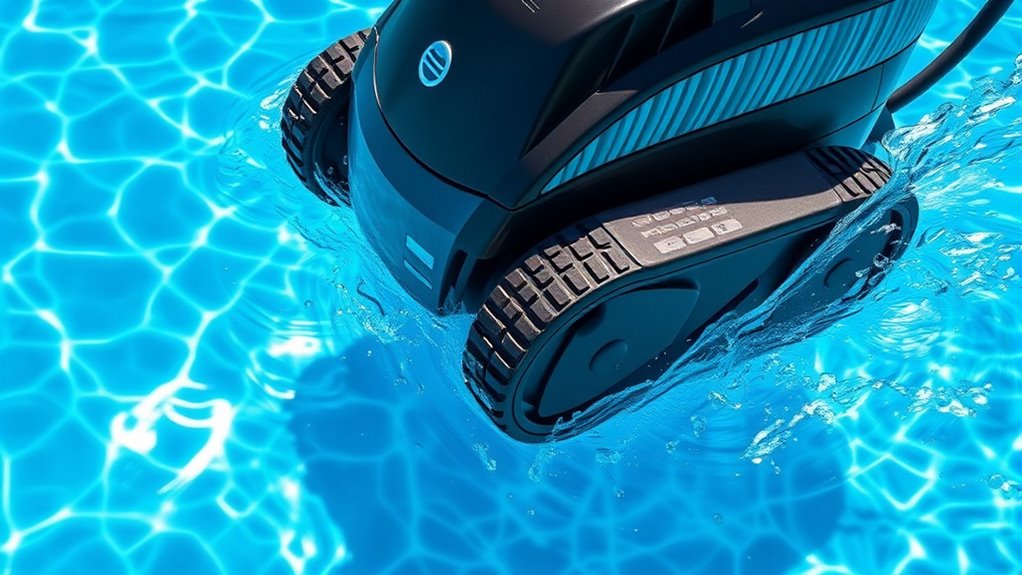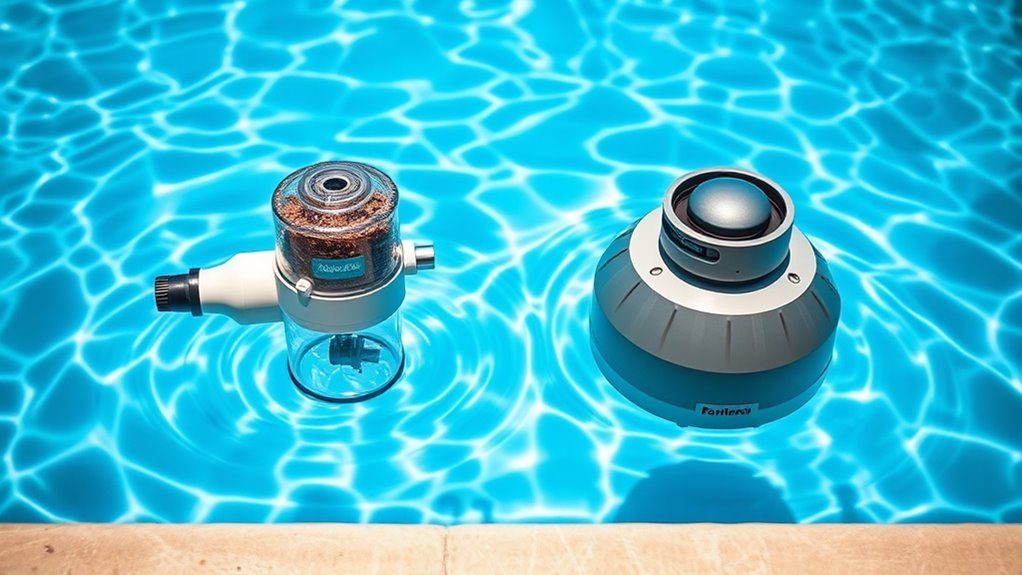Switching from a suction to a pressure pool cleaner can make your pool cleaning faster and more effective. Pressure cleaners use water pressure from your pump or a booster, covering more ground and tackling tougher debris. Before switching, check your pump and plumbing for compatibility, and confirm hoses and jets are unobstructed. Proper maintenance and understanding setup steps will improve performance. To discover more tips on making the switch smoothly, keep exploring the details below.
Key Takeaways
- Confirm your pool pump and plumbing are compatible with the higher flow requirements of a pressure cleaner.
- Install the pressure cleaner according to manufacturer instructions, ensuring hoses and jets are unobstructed.
- Use a suitable booster or pool pump to provide adequate water pressure for optimal cleaning.
- Regularly inspect and maintain hoses, filters, and jets to prevent clogs and ensure effective operation.
- Adjust cleaner settings based on your pool surface for better coverage and efficiency.

If you’re considering upgrading your pool cleaning system, switching from a suction cleaner to a pressure cleaner can improve efficiency and performance. A pressure cleaner often covers more ground faster and handles tougher debris better, making pool maintenance easier and less time-consuming. Before making the switch, it’s important to understand how these systems differ and what benefits you’ll gain. Proper pool cleaner maintenance becomes even more crucial when transitioning to a pressure cleaner, as these units generally have more moving parts and higher operational demands. Regularly checking hoses, connections, and the cleaner’s brushes ensures peak performance and prevents breakdowns. Keeping your equipment in top shape means fewer surprises and a cleaner pool with less effort.
Switching to a pressure cleaner can seem intimidating at first, but with a clear understanding of its operation, you’ll quickly see the advantages. Unlike suction cleaners that rely on the vacuum created by the pool’s filter system, pressure cleaners use water pressure from a dedicated booster pump or your pool’s existing pump to move and scrub the pool floor and walls. This means you’ll need to confirm your pump and plumbing are compatible and capable of handling the increased flow. Familiarize yourself with the manufacturer instructions to avoid common issues, such as leaks or insufficient pressure, which can hinder cleaning performance. Following pool cleaning tips, like regularly inspecting hoses for holes or cracks, will prolong the lifespan of your equipment and maintain its efficiency. Additionally, understanding the importance of dynamic contrast ratios can help you evaluate the effectiveness of your pool’s lighting and water clarity, ensuring optimal viewing conditions during nighttime pool use.
Once installed, a pressure cleaner typically requires less manual intervention. It can navigate around obstacles more easily and often has adjustable settings for different pool surfaces, giving you greater control over cleaning coverage. However, because pressure cleaners operate differently, you’ll want to refine your pool cleaner maintenance routine. This includes cleaning the filter bag or canister frequently, as pressure cleaners tend to collect more debris, especially if your pool has lots of leaves or algae. Ensuring the cleaner’s wheels and brushes are in good condition helps maximize cleaning power and reduces wear. Incorporate these pool cleaning tips into your routine: check for tangled hoses, clear obstructions, and verify that the cleaner’s jets are unobstructed to keep the system running smoothly. Additionally, selecting the right pressure pump can make a significant difference in cleaning efficiency and longevity of your equipment. Being aware of proper system compatibility can prevent potential issues and ensure your upgrade is successful. Properly maintaining your system and understanding its operational requirements will help you achieve a cleaner, healthier pool with less effort.
Frequently Asked Questions
How Do I Know When to Switch Pool Cleaners?
You’ll know it’s time to switch pool cleaners when your current equipment isn’t effectively maintaining your pool’s cleanliness. If you notice a decline in cleaning frequency or debris isn’t being removed properly, it’s a sign. Check your equipment compatibility too—upgrading might be necessary if your current cleaner isn’t suitable for your pool size or shape. Switching can improve efficiency and keep your pool sparkling clean.
Are Pressure Cleaners More Energy-Efficient Than Suction Models?
Powerful pressure pool cleaners typically tend to be more energy-efficient than suction models. They consume less energy because they use water pressure from the pump rather than relying heavily on the pool’s filtration system. This means you save on energy consumption while boosting cleaning efficiency. If you’re after a cleaner that cuts costs and cleans thoroughly, pressure cleaners are a practical pick, providing powerful, efficient, and economical pool cleaning.
Can I Use a Pressure Cleaner With a Robotic System?
You can use a pressure cleaner with a robotic system, but you’ll need to check pool filter compatibility first. Confirm your filter can handle the increased debris and pressure from a pressure cleaner. Also, consider robotic system integration, as some robotic cleaners work better with specific pressure cleaners. Always follow manufacturer guidelines to prevent damage and ensure efficient cleaning, making your pool maintenance smoother and more effective.
What Maintenance Is Required After Switching to a Pressure Cleaner?
After switching to a pressure pool cleaner, you’ll need to inspect your filter regularly to verify it isn’t clogged and maintains proper flow. Additionally, check the hose for any signs of wear or damage, replacing it if necessary to keep the cleaner functioning effectively. Regular maintenance like cleaning the filter and replacing the hose when needed will help prolong your cleaner’s lifespan and keep your pool spotless.
Will Switching Cleaners Improve My Pool’s Cleaning Time?
Imagine your pool sparkling like a jewel—switching cleaners could make that dream a reality. While it might seem like a small change, a pressure pool cleaner often boosts cleaning effectiveness and extends the pool cleaner lifespan. This means quicker, more thorough cleaning sessions, saving you time and effort. So, yes, switching could definitely improve your pool’s cleaning time, giving you more moments to enjoy your crystal-clear oasis.
Conclusion
Switching from a suction to a pressure pool cleaner can make your pool maintenance easier and more efficient. Did you know that pressure cleaners can cover up to 50% more area in half the time? This means less effort for you and a cleaner pool faster. If you’re looking to upgrade, this switch could save you hours each week, giving you more time to enjoy your sparkling, pristine pool.









